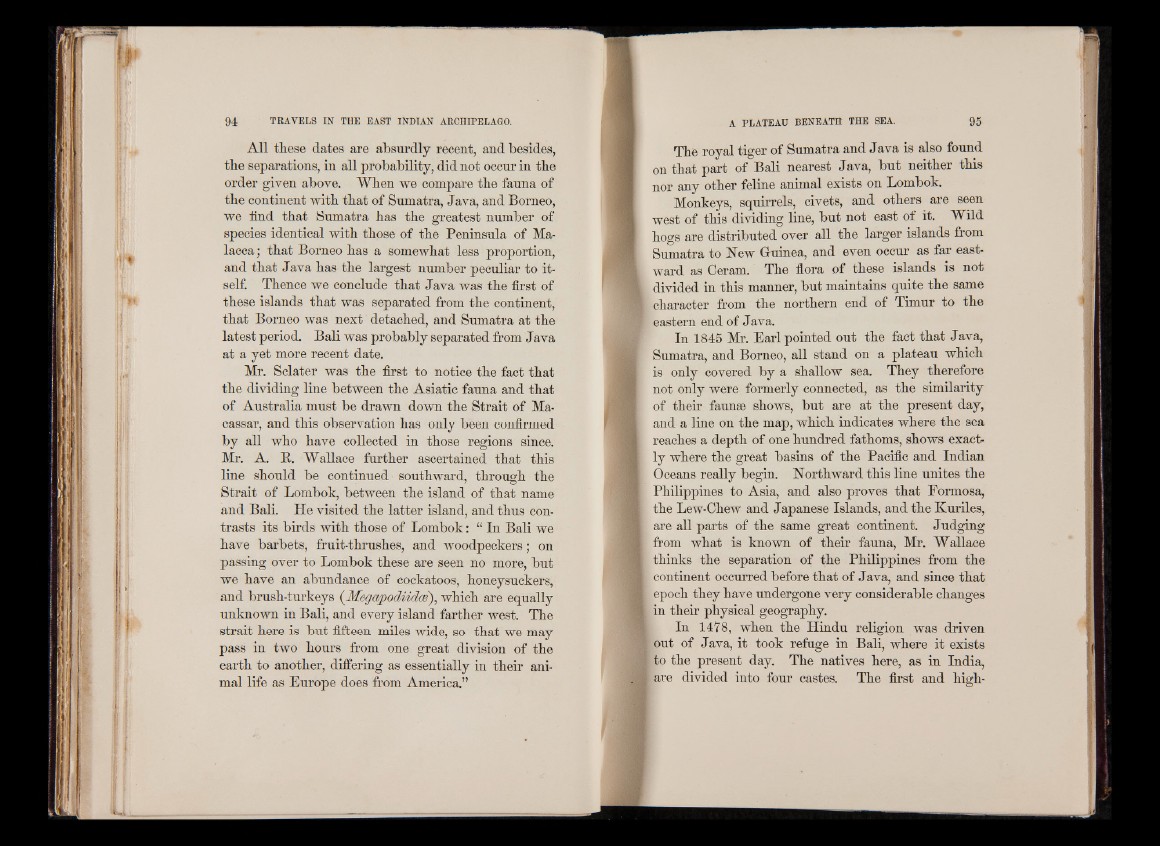
All these dates are absurdly recent, and besides,
the separations, in all probability, did not occur in the
order given above. When we compare the fauna of
the continent with that of Sumatra, Java, and Borneo,
we find that Sumatra has the greatest number of
species identical with those of the Peninsula of Malacca;
that Borneo has a somewhat less proportion,
and that Java has the largest number peculiar to itself.
Thence we conclude that Java was the first of
these islands that was separated from the continent,
that Borneo was next detached, and Sumatra at the
latest period. Bali was probably separated from Java
at a yet more recent date.
Mr. Sclater was the first to notice the fact that
the dividing line between the Asiatic fauna and that
of Australia must be drawn down the Strait of Macassar,
and this observation has only been confirmed
by all who have collected in those regions since.
Mr. A. R. Wallace further ascertained that this
line should be continued southward, through the
Strait of Lombok, between the island of that name
and Bali. He visited the latter island, and thus contrasts
its birds with those of Lombok: “ In Bali we
have barbets, fruit-thrushes, and woodpeckers; on
passing over to Lombok these are seen no more, but
we have an abundance of cockatoos, honeysuckers,.
and brush-turkeys (Megapodiidoe), which are equally
unknown in Bali, and every island farther west. The
strait here is but fifteen miles wide, so that we may
pass in two hours from one great division of the
earth to another, differing as essentially in their animal
life as Europe does from America.”
The royal tiger of Sumatra and Java is also found
on that part of Bali nearest Java, but neither this
nor any other feline animal exists on Lombok.
Monkeys, squirrels, civets, and others are seen
west of this dividing line, but not east of it. Wild
hogs are distributed over all the larger islands from
Sumatra to Hew Gruinea, and even occur as far eastward
as Ceram. The flora of these islands is not
divided in this manner, but maintains quite the same
character from the northern end of Timur to the
eastern end of J ava.
In 1845 Mr. Earl pointed out the fact that Java,
Sumatra, and Borneo, all stand on a plateau which
is only covered by a shallow sea. They therefore
not only were formerly connected, as the similarity
of their faunae shows, but are at the present day,
and a line on the map, which indicates where the sea
reaches a depth of one hundred fathoms, shows exactly
where the great basins of the Pacific and Indian
Oceans really begin. Horthward this line unites the
Philippines to Asia, and also proves that Formosa,
the Lew-Chew and Japanese Islands, and the Kuriles,
are all parts of the same great continent. Judging
from what is known of their fauna, Mr. Wallace
thinks the separation of the Philippines from the
continent occurred before that of Java, and since that
epoch they have undergone very considerable changes
in their physical geography.
In 1478, when the Hindu religion was driven
out of Java, it took refuge in Bali, where it exists
to the present day. The natives here, as in India,
are divided into four castes. The first and high